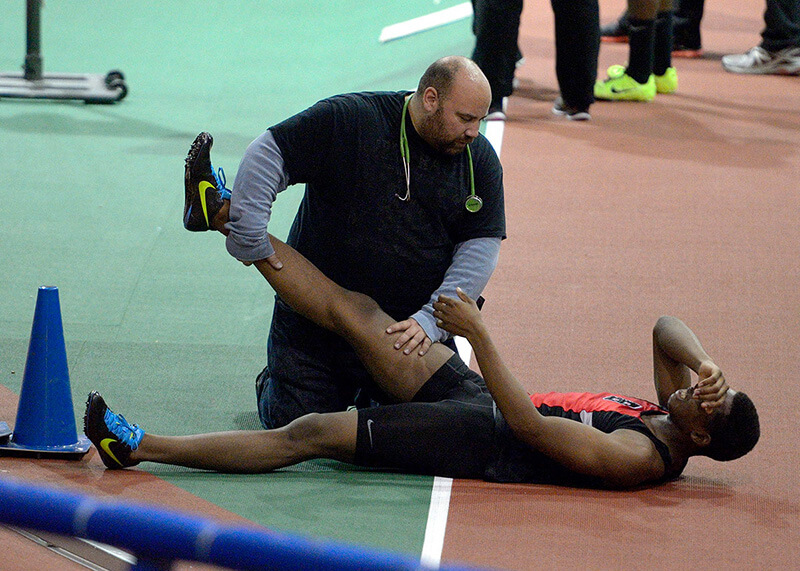As well as prompting an incredible response from the medical field, the ongoing COVID-19 pandemic has dramatically changed everyday life across the world.
Virtually all basic human routines have been changed, including the ability to watch, follow and support your favorite sports teams, or athletes.
Though some international sports leagues are showing signs of restarting, the 2020 Tokyo Olympics remains postponed, while professional sport across America remains largely suspended due to the ongoing health crisis.
Indeed, sports itself has been on pause, giving athletes a chance to rest their bodies like no other time in recent decades.
Many believe that sports medicine will make its most significant contributions in the area of prevention. The benefit to health and quality of life from participation in physical activity – at all levels – is clearly apparent.
Keeping those finely tuned machines capable of incredible acts of athleticism is the role of sports medicine in our society, a field that has grown almost exponentially as the popularity of sports within it has, too.
A good sports doctor must cover a large reach of areas within medicine, offering unique challenges, and rewards, in succeeding (athletes can go the other way, too, like former OnlineMedEd student, and Super Bowl-winning NFL star, Laurent Duvernay-Tardif.
“Sports medicine has always been difficult to define because it involved a wide scope of healthcare for professional athletes and recreationally active individuals,” Dr. Emin Ergen, an influential Qatari professor in the field, wrote in the ASPETAR Sports Medicine Journal.
“It provides them with diagnostic, curative, rehabilitative, and preventive medical services. Athletes and active individuals demand expertise and sport-specific knowledge, for issues varying from musculoskeletal to environmental stresses; cardiological to dermatological, and endocrinological to psychological.
“The moral, legal, and health-related challenges (such as doping) surrounding professional athletes further contribute to the unique and complex picture presented to the doctors who treat them.
“Finally, prevention is an area of increasingly specialized interest, knowledge, and expertise. Many believe that sports medicine will make its most significant contributions in the area of prevention. The benefit to health and quality of life from participation in physical activity – at all levels – is clearly apparent.”
Doctors had been seeing the connection between the two, long before the field of sports medicine even really existed.
Ancient Greek doctor Herodicus is often recognized as “the father of sports medicine”, improving standards of health and fitness for early athletes. Roman physician Galen, who hailed from modern-day Turkey, served as a ‘gladiators’ doctor’ in the second century AD, gaining enduring insights.
Outside basic early support of amateur athletes, American sports medicine became a formalized field in 1890, when Harvard introduced it as a class. Its findings would assist their rowing eight winning the celebrated Harvard-Yale Regatta in 1899, and change the rules of American Football, leading to dramatically fewer injuries.
In an operation destined to become one of the most common amongst modern athletes, English surgeon Sir Arthur Mayo-Robson fixed a torn anterior cruciate ligament (ACL) for the first time in 1895.
By the 1930s, increasing professionalism alerted athletes to the importance of a fit, healthy body. The powerful International Federation of Sports Medicine was formed in 1928, while German physicians Arthur Mallwitz and August Bier became leaders in the field.
Resources improved as the popularity of sports grew throughout the 20th century, as professional leagues and strong player unions worked more closely with physicians and team trainers.
Careers could now be salvaged, as evidenced by pro baseball pitcher Tommy John. performed by California’s Frank Jobe in 1974, his was the first-ever ulnar collateral ligament reconstruction, giving him 15 more years in the sport. Forty-six years later, many baseball players are able to continue playing, following a successful ‘Tommy John’ surgery.
More recently, improvements in arthroscopic surgery, and the recognition of concussions in contact sports, have changed – and expanded – the field further.
“Back in the ‘70s and ‘80s, you’d see these scars that were six inches long across the patient’s knee, and now we can do it through basically a few poke holes and a one-inch incision,” Dr. David Geier, a director in sports medicine at the Medical University of South Carolina told The Atlantic, in 2011.
“Now they get their motion back typically faster, and they get their strength back because you haven’t done as much damage to do the surgery in the first place.”
The shocking deaths, by suicide, of former NFL players like Junior Seau led to a spotlight on concussions and their links to degenerative brain diseases. Removing headers from soccer may become likely, with youth leagues across the world already removing them as taught skills.
“It’s a funny game that you intentionally bash your head,” cognitive neuroscientist Magdalena Ietswaart told the New York Times in 2016.
“Only recently have we realized quite how much the brain is still under construction right through teenagehood.”
Though the influence of medicine on athletic endeavors is far greater than Herodicus or Galen could have ever imagined, recognizing what is important for the body to perform at its best remains the fundamental driving force of sports medicine.
When organized sports do come back after the COVID-19 crisis, the value of seeing the concept in action will only, surely, grow.



